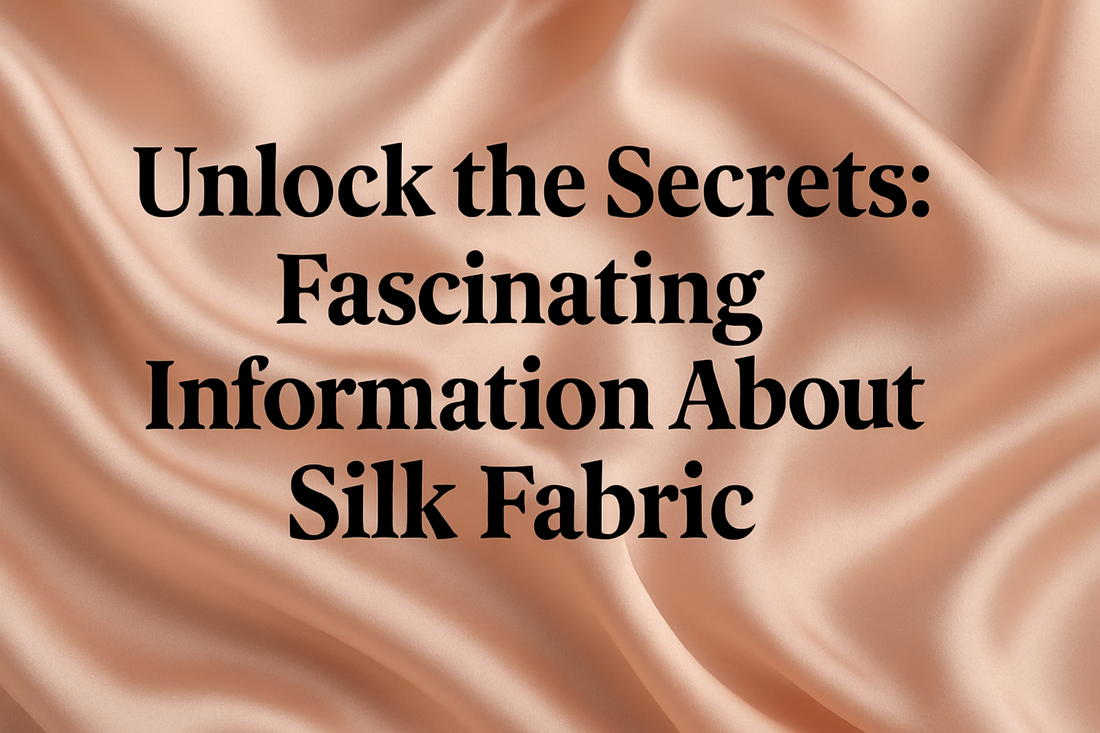The Enchanting World of Silk Fabric
Silk, the epitome of luxury in textiles, has captivated the fashion world for millennia. This lustrous fiber, born from the humble silkworm, transforms into garments that drape with unmistakable elegance across the human form. For the style-conscious fashionista navigating today's trends, understanding silk's rich heritage and unique properties offers invaluable insight into why this fabric continues to reign supreme in high-fashion circles. Join us as we unravel the mysteries behind this timeless textile that has adorned emperors and influencers alike.
The Ancient Origins of Silk
The story of silk begins in ancient China, where for thousands of years, the secrets of silk production were guarded with imperial fervor. According to legend, the discovery of silk occurred around 2700 BCE when Chinese empress Leizu accidentally dropped a silkworm cocoon into her tea, witnessing the unraveling of the lustrous thread that would change textile history forever.
The Silk Road Legacy
The allure of silk sparked one of history's most significant trade networks – the legendary Silk Road. This vast web of routes connected East and West, facilitating not just the exchange of this coveted textile but also ideas, cultures, and innovations. Caravans traversed treacherous terrain, carrying silk that would fetch prices worth its weight in gold. The Byzantine Empire eventually broke China's monopoly when monks smuggled silkworm eggs in hollow walking sticks, forever altering the geopolitical landscape of luxury textiles.
"Silk was so valuable in ancient Rome that it was worth its weight in gold. Emperor Tiberius once scolded his wife for wearing diaphanous silk garments in public, considering them too revealing and extravagant."
How Silk Is Made: Nature's Miracle Thread
The metamorphosis from silkworm to sumptuous fabric represents one of nature's most remarkable transformations. The Bombyx mori, domesticated over millennia specifically for silk production, creates its cocoon from a single continuous filament that can stretch up to 1,800 feet long – an architectural marvel of the natural world.
The Sericulture Process
Sericulture, the cultivation of silkworms for silk production, involves meticulous attention to detail. Silkworms feast exclusively on mulberry leaves during their brief but voracious larval stage. As they prepare to pupate, these specialized caterpillars extrude liquid silk from their salivary glands, which solidifies upon contact with air. This protein fiber, predominantly composed of fibroin, creates the structural thread, while sericin acts as a natural adhesive binding the fibers together.
The harvesting process traditionally requires the sacrifice of the metamorphosing pupae through boiling, which simultaneously softens the sericin to allow unwinding of the continuous filament. This ethically complex aspect of conventional silk production has led to the development of peace silk or ahimsa silk, where the moth is permitted to emerge before the cocoon is harvested, though this results in shorter, less uniform fibers.
Distinctive Properties That Set Silk Apart
Silk possesses a constellation of characteristics that elevate it above other textiles in both performance and perception. Its natural protein structure creates a fabric that feels almost supernatural against the skin while delivering practical benefits that synthetic alternatives struggle to replicate.
Unparalleled Comfort and Performance
The microscopically smooth surface of silk fibers creates the hallmark luminosity and tactile experience that defines this extraordinary textile. Beyond its aesthetic appeal, silk demonstrates remarkable thermoregulatory properties, keeping wearers cool in summer and surprisingly warm in winter due to its natural insulating capacity.
Silk's hygroscopic nature allows it to absorb up to 30% of its weight in moisture without feeling damp, making it exceptionally breathable. For fashion-forward individuals concerned with both style and substance, silk's hypoallergenic properties and natural resistance to dust mites, mold, and mildew make it an intelligent choice for those with sensitive skin or allergies.
| Property | Benefit |
|---|---|
| Thermoregulation | Adapts to body temperature; cool in summer, warm in winter |
| Hygroscopic | Absorbs moisture while remaining dry to touch |
| Hypoallergenic | Naturally resistant to dust mites, mold, and common allergens |
| Tensile Strength | Stronger than comparable diameter steel wire when dry |
Varieties of Silk: A Textile Taxonomy
While most associate silk with a single homogeneous fabric, connoisseurs recognize the diverse ecosystem of silk varieties, each with distinct characteristics and applications in contemporary fashion. Understanding these variations allows the discerning fashionista to make informed choices for specific garments and occasions.
From Mulberry to Spider: Nature's Silk Spectrum
Mulberry silk represents approximately 90% of global silk production, prized for its uniform color, texture, and impressive durability. Its supremely long fibers create the most lustrous and refined silk fabrics available commercially. In contrast, Tussar silk, produced by wild silkworms feeding on oak and juniper leaves, exhibits a more textured, rustic appearance with its characteristic golden hue and slightly coarser hand-feel.
Eri silk, sometimes called "peace silk," allows the silkworm to complete its lifecycle, resulting in shorter fibers with a wool-like texture perfect for casual yet luxurious garments. For the truly avant-garde fashion enthusiast, spider silk represents the ultimate in natural textile innovation—stronger than steel by weight, with elasticity surpassing any natural fiber, though commercial production remains largely experimental.
- Mulberry Silk: The classic, refined option with superior luster and smooth texture
- Tussar Silk: Wild silk with natural golden color and textural interest
- Eri Silk: Ethical alternative with matte finish and wool-like warmth
- Muga Silk: Rare golden silk from Assam with exceptional durability
- Spider Silk: The frontier of natural textiles with unmatched strength-to-weight ratio
Silk in Contemporary Fashion
The relationship between silk and high fashion remains as symbiotic today as it was in imperial courts millennia ago. Modern designers continually rediscover and reinterpret silk's potential, finding new expressions for this ancient material that resonates with contemporary aesthetics and lifestyle demands.
From Runway to Ready-to-Wear
On international runways, silk maintains its prestigious position through perennial classics like the bias-cut slip dress—a silhouette that capitalizes on silk's exceptional drape and luminosity. Innovative designers experiment with silk's architectural potential, creating structural pieces that challenge conventional notions of how this fluid fabric can behave when manipulated through specialized techniques like honeycomb smocking or origami-inspired pleating.
In ready-to-wear collections, silk elevates everyday pieces through strategic incorporation. The silk camisole has transcended its lingerie origins to become a versatile layering staple, while the silk scarf offers perhaps the most accessible entry point to this luxury fiber, allowing fashion enthusiasts to incorporate a touch of opulence into even casual ensembles.
Caring for Silk: Preserving Your Investment
The longevity of silk garments depends largely on proper care techniques. While silk possesses natural resilience, its protein structure requires specific attention to maintain its characteristic luster and hand-feel through repeated wear and cleaning.
Maintenance Rituals for Silk Enthusiasts
Contrary to popular misconception, silk can be washed—albeit with attentive care. Gentle hand-washing with pH-neutral detergents specially formulated for delicate proteins preserves silk's integrity. The temperature shock of cold water after cleaning should be avoided, as this can cause unwanted creasing and fiber stress.
Storage demands equal consideration; silk should rest on padded hangers or be rolled rather than folded to prevent permanent crease lines. Additionally, this natural fiber requires protection from direct sunlight, which can degrade the protein structure and cause discoloration over time. For seasonal storage, avoid plastic containers which trap moisture; instead, choose breathable cotton garment bags that allow air circulation while protecting from dust.
Frequently Asked Questions About Silk
Addressing Common Silk Curiosities
What makes silk so expensive compared to other natural fibers?
Silk's price reflects its labor-intensive production process—it takes approximately 2,500 silkworms consuming 40,000 mulberry leaves to produce one pound of raw silk. Additionally, the specialized knowledge required for cultivation, the manual nature of harvesting, and limited production regions globally all contribute to silk's premium positioning in the textile market.
Is silk environmentally sustainable?
Silk occupies a complex position in sustainability discussions. While biodegradable and produced from renewable resources, conventional silk production involves intensive agricultural practices for mulberry cultivation and raises ethical questions regarding silkworm treatment. However, compared to petroleum-based synthetic alternatives, silk generally presents a smaller environmental footprint when considering its complete lifecycle and exceptional durability.
Can silk be worn year-round?
Absolutely. Silk's natural temperature-regulating properties make it one of the few textiles appropriate for all seasons. Its ability to insulate in cooler temperatures while wicking moisture away during warmer periods creates a versatile fabric that adapts to changing conditions. This multifaceted performance aspect explains silk's enduring presence in fashion collections regardless of season.
In embracing silk as part of your fashion repertoire, you connect with a legacy spanning millennia while simultaneously engaging with one of nature's most sophisticated materials. For today's fashion-forward individual, silk represents not merely a luxury but a statement of discernment—a recognition that true style transcends trends through materials that have proven their worth across civilizations and centuries.

